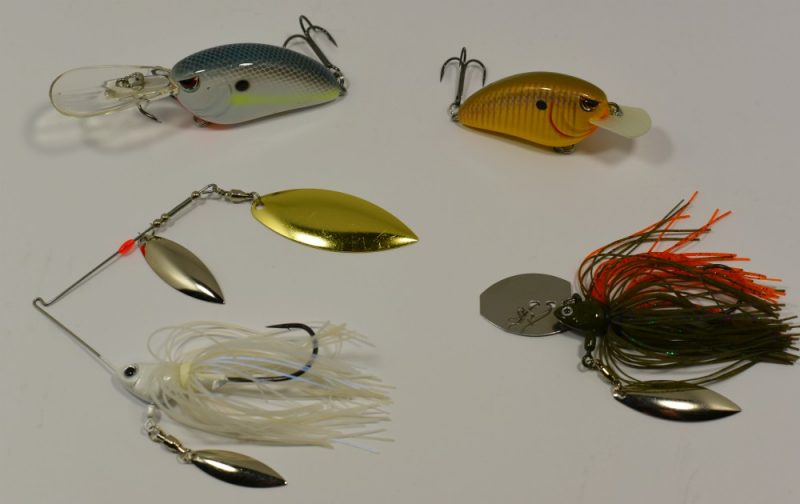Bass Tip: How Weather Can Help You Choose the Right Lure
OutdoorHub Reporters 02.09.18

We’ve all heard it: “You should have been here yesterday.” But do you ever wonder what drives a hot bite?
Is it a new lure on the market? A body of water that’s lacking forage, so bass are on a feeding frenzy? Or maybe the weather is the driving force?
If you answered “weather,” I think you’re correct. Most of the time, weather is the single largest factor in determining fish feeding behavior. In this article, I’ll take a closer look at how weather makes bass do what they do, day in and day out, and how you can react to get more fish over the side of your boat.

Let me set a little ground work to get started. As fishermen, we do two different retrieves: horizontal and vertical. A horizontal presentation is casting out a lure, then reeling it back to the boat. Examples are crankbaits, spinnerbaits, buzz baits, or lures for trolling.
A vertical presentation is a lure that you cast, let it settle to the bottom or near the bottom, then work it slowly back to the boat. Examples of a vertical presentation include a jig-n-craw, Texas-rig soft plastic, shaky head, just to name a few.
It is critical for success to put the odds in your favor by using the presentation style, either vertical or horizontal, that best matches the given weather conditions.

Weather Conditions
We have weather around us every day. It not only dictates how we dress, but it also affects how we fish. We get weather information from our daily news, and most of us have it at our fingertips on smartphones.
We hear weather terms all the time, but what affect will it have on my fishing, and how do I need to adjust to put the odds in my favor? Let’s breakdown weather, its terms, and explain how it will likely affect your bass fishing. Most importantly, I’ll talk about how you can make adjustments to catch fish.
High Pressure/Cold Front: We hear this term all the time; it means that we will have conditions that generally will have little or no clouds in the sky. These are the days that we anglers enjoy on the water, but the bite is often tougher. Bass react to cold front conditions by shutting down, and either bury deep in cover, or move toward deeper water. Many fishermen relate this location move to the pressure change that is happening, and the fact that fish don’t have eyelids to cope with the brighter sky.
So, the big question: What presentation would you use?

In high pressure/cold front conditions, you should first try a vertical presentation. Bass in these conditions won’t usually be in a chasing mood, and many times they won’t come up out of cover or hit a lure pulled over their heads. To get strikes, you’ll have to get your lure right next to the fish. A jig-n-craw, Texas-rigged worms/craws, and similar lures are all good choices to use in cold front situations.
Low Pressure/Warm Front: Stable weather with warming fronts that will soon start to turn into rain or stormy conditions can be great for angling. Bass will have a tendency to eat during these conditions. During these weather conditions, you can use a mix of lures to trigger bites. On these days, you can mix both vertical and horizontal presentations to your benefit. You’ll be able to take the active fish using a horizontal presentation such as crankbaits and spinnerbaits, then follow up with a vertical presentation to trigger strikes from the less-active bass holding tighter on structure.
Rain and Storms: The phrase “you should have been here yesterday” was made to describe these fantastic fishing days. The weather is going to be active, and so are the bass. Predictions of storms hitting sometime during the day warn the angler what the fish already know, that a change is coming. It’s my opinion that bass put on the feed bag because they know what follows the storm when it clears: cold front conditions. After the storm passes and clear skies dominate, bass will likely burrow into heavy cover and not eat much, or anything, for a day or two.
During these conditions, you don’t have to trigger these bass to bite; you just have to get your lure in front of them. If they can see/find your lure, they’re likely to strike. To put the odds in your favor, the best plan is to cover water rather quickly. I prefer a horizontal presentation all the way. Make long casts, use loud baits, and cover water. Keep casting and winding.

Important point: During pre-storm conditions, bass are likely to be biting well, but if the storm has a lot of lightning and thunder, then that will have a negative effect on the fish. If the storm is mild with little thunder and lightning, then the bite will continue. Of course, it’s not worth risking your life to fish in the presence of lightning; get off the water immediately. When it’s safe to resume fishing after a bad lightning storm, you’ll probably have to slow down your presentation to get strikes; i.e. try vertical presentations, just as if you were fishing in cold front conditions.
As you can see, weather affects bass activity in important ways. The good news is that by making the proper adjustments, and using the correct presentations, you can save the day when the bite becomes tough.
P.S. Remember to practice CPR: Catch, Photo and Release. The future of fishing is in your hands.


